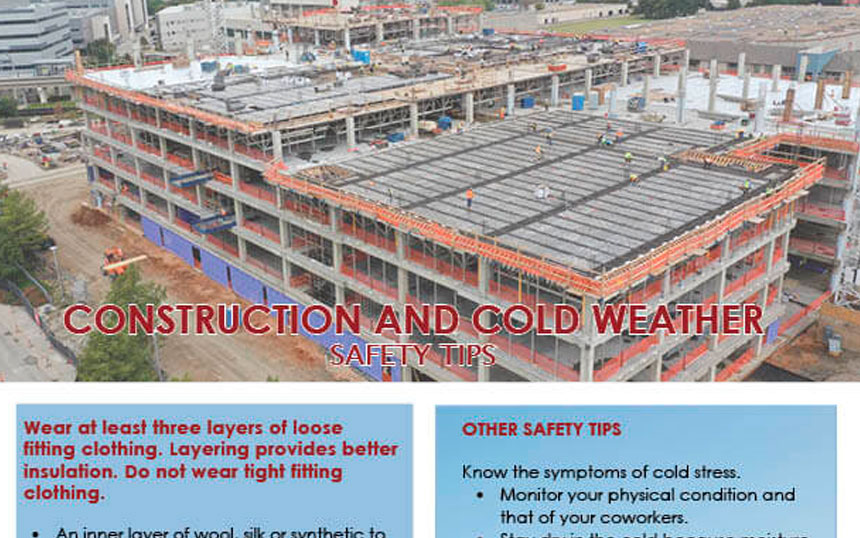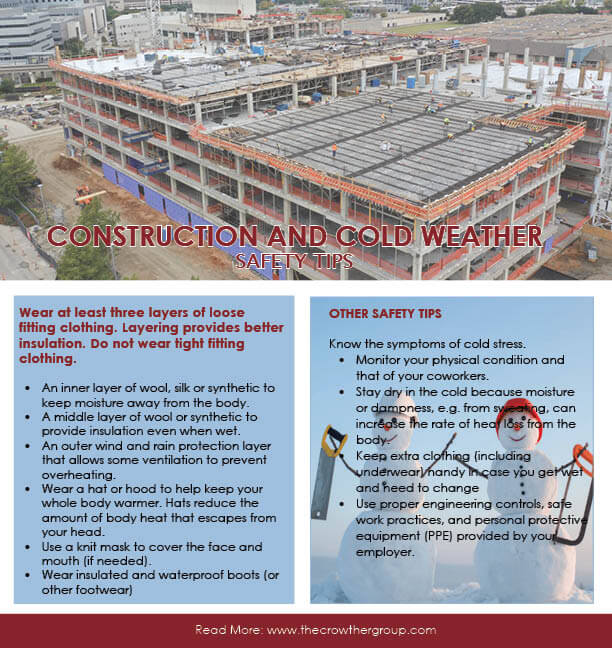
22 NOV, 2019
Staying Safe in the Cold Season

The fall season brings unpredictable weather and cold temperatures which can make staying warm, dry, and compliant a challenge. After our first big cold front of the season we wanted to share some helpful tips for staying safe. It is very important we recognize the hazards that come with cold weather and how to overcome them.
Working in the cold winter weather is very similar in some ways as working in the extreme heat: you must be prepared for it, you have to be equipped for it and you have to get accustomed to it.
For example, it is easy to become dehydrated in cold weather. Typically, we think of that as a heat related issue but it holds true for the cold also. Drink plenty of fluids prior to working. Warm sweetened liquids can be especially helpful. Avoid alcoholic drinks. Remember, it is as important to hydrate yourself PRIOR to starting work as it is during the actual physical activity.
Dressing properly is extremely important to preventing cold stress. The type of fabric worn also makes a difference. Cotton loses its insulation value when it becomes wet. Wool, silk and most synthetics, on the other hand, retain their insulation even when wet. Keep the following recommendations in mind when working in cold environments:
- Wear at least three layers of loose-fitting clothing. Layering provides better insulation. Do not wear tight fitting clothing.
- An inner layer of wool, silk or synthetic to keep moisture away from the body.
- A middle layer of wool or synthetic to provide insulation even when wet.
- An outer wind and rain protection layer that allows some ventilation to prevent overheating.
- Wear a hat or hood to help keep your whole body warmer. Hats reduce the amount of body heat that escapes from your head.
- Use a knit mask to cover the face and mouth (if needed).
- Wear insulated and waterproof boots (or other footwear).
Like the heat, you have to allow yourself to get acclimated to the cold weather. The first day out in frigid weather can be quite challenging so, it’s best to start off very slow allowing your body to get used to the weather. It is also important that if you are doing a very active job outside, that you do stretching exercises inside prior to starting the tasks outside. This will allow your muscles to warm up appropriately rather than the initial shock of being active in a very cold environment.
If possible, schedule heavy work during the warmer part of the day. It is best to work in pairs (buddy system), so that they can monitor each other for signs of cold stress. Remember, if you are feeling uncomfortable, STOP, take a break. Take frequent breaks in warm areas to prevent cold stress.
Other Safety Tips:
- Know the symptoms of cold stress.
- Cold, tingling, stinging or aching feeling in the frostbitten area, followed by numbness.
- Skin color turns red, then purple, then white or very pale skin, cold to the touch.
- Hard or blistering skin in severe cases
- Monitor your physical condition and that of your coworkers.
- Stay dry in the cold because moisture or dampness, e.g., from sweating, can increase the rate of heat loss from the body.
- Keep extra clothing (including underwear) handy in case you get wet and need to change
- Use proper engineering controls, safe work practices, and personal protective equipment (PPE) provided by your employer.”





Comments are closed here.